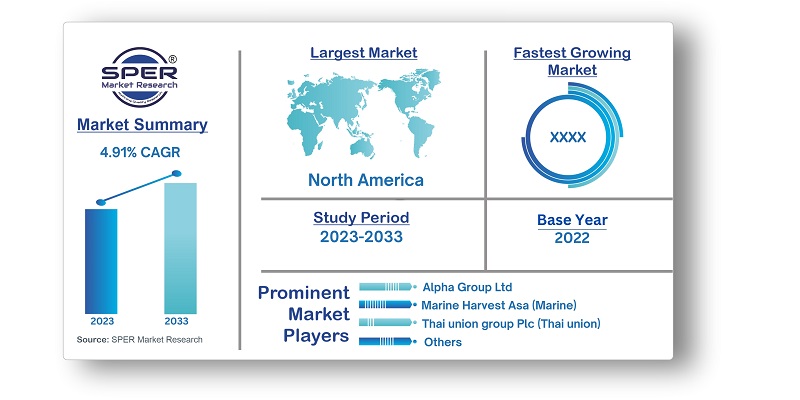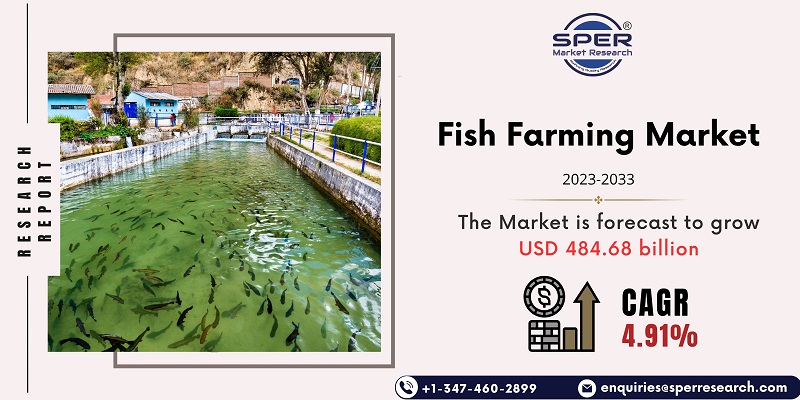
Fish Farming Market Growth, Size, Trends, Demand, Revenue, Share, Challenges and Future Outlook
Fish Farming Market Size- By Environment, By Fish Type- Regional Outlook, Competitive Strategies and Segment Forecast to 2033
| Published: Dec-2023 | Report ID: AGRI2358 | Pages: 1 - 217 | Formats*: |
| Category : Agriculture | |||
- January 2022: The Indonesian government said that it planned to establish a network of dozens of towns with aquaculture farms by the end of the year, in an attempt to expedite the post-pandemic economic recovery.
- December 2022: The US Department of Energy's (DOE) Water Power Technologies Office (WPTO) declared that it will allocate about USD 16 million towards fresh research and development projects related to hydropower and marine energy.


| Report Metric | Details |
| Market size available for years | 2019-2033 |
| Base year considered | 2022 |
| Forecast period | 2023-2033 |
| Segments covered | By Environment, By Type |
| Regions covered | North America, Asia-Pacific, Latin America, Middle East & Africa and Europe |
| Companies Covered | Alpha Group Ltd., Cermaq Group As (Mitsubishi Corporation), Cooke Fish Farming, Fish Farming technologies Asia limited , Marine Harvest Asa (Marine), Nippon Suisan Kaisha ltd., P/f Bakkafrost (Bakkafrost), Thai union group Plc (Thai union), Others |
- Commercial Fishermen
- Fish Farmers
- Fish Farmers and Aqua culturists
- Fishing Gear Manufacturers
- Boat and Vessel Manufacturers
- Seafood Processing Companies
- Seafood Distributors and Wholesalers
- Retailers and Grocery Stores
- Restaurants and Food Service Providers
- Government Fisheries Departments
| By Environment: |
|
| By Fish Type: |
|
| By Region: |
|
- Global Fish Farming Market Size (FY’2023-FY’2033)
- Overview of Global Fish Farming Market
- Segmentation of Global Fish Farming Market By Fish Type (Brackish Water, Marine Water, Fresh Water)
- Segmentation of Global Fish Farming Market By Environment (Catfish, Groupers, Milkfish, Pompano, Salmon, Sea bass, Snappers, Tilapia, Tuna, Others)
- Statistical Snap of Global Fish Farming Market
- Expansion Analysis of Global Fish Farming Market
- Problems and Obstacles in Global Fish Farming Market
- Competitive Landscape in the Global Fish Farming Market
- Impact of COVID-19 and Demonetization on Global Fish Farming Market
- Details on Current Investment in Global Fish Farming Market
- Competitive Analysis of Global Fish Farming Market
- Prominent Players in the Global Fish Farming Market
- SWOT Analysis of Global Fish Farming Market
- Global Fish Farming Market Future Outlook and Projections (FY’2023-FY’2033)
- Recommendations from Analyst
1.1. Scope of the report1.2. Market segment analysis
2.1. Research data source2.1.1. Secondary Data2.1.2. Primary Data2.1.3. SPER’s internal database2.1.4. Premium insight from KOL’s2.2. Market size estimation2.2.1. Top-down and Bottom-up approach2.3. Data triangulation
4.1. Driver, Restraint, Opportunity and Challenges analysis4.1.1. Drivers4.1.2. Restraints4.1.3. Opportunities4.1.4. Challenges4.2. COVID-19 Impacts of the Global Fish Farming Market
5.1. SWOT Analysis5.1.1. Strengths5.1.2. Weaknesses5.1.3. Opportunities5.1.4. Threats5.2. PESTEL Analysis5.2.1. Political Landscape5.2.2. Economic Landscape5.2.3. Social Landscape5.2.4. Technological Landscape5.2.5. Environmental Landscape5.2.6. Legal Landscape5.3. PORTER’s Five Forces5.3.1. Bargaining power of suppliers5.3.2. Bargaining power of buyers5.3.3. Threat of Substitute5.3.4. Threat of new entrant5.3.5. Competitive rivalry5.4. Heat Map Analysis
6.1. Global Fish Farming Market Manufacturing Base Distribution, Sales Area, Product Type6.2. Mergers & Acquisitions, Partnerships, Product Launch, and Collaboration in Global Fish Farming Market
7.1. Global Fish Farming Market Value Share and Forecast, By Environment, 2023-2033
7.2. Brackish Water7.3. Marine Water7.4. Fresh Water
8.1. Global Fish Farming Market Value Share and Forecast, By Fish Type, 2023-20338.2. Catfish8.3. Groupers8.4. Milkfish8.5. Pompano8.6. Salmon8.7. Sea bass8.8. Snappers8.9. Tilapia8.10. Tuna8.11. Others
9.1. Global Fish Farming Market Size and Market Share
10.1. Global Fish Farming Market Size and Market Share By Environment (2019-2026)10.2. Global Fish Farming Market Size and Market Share By Environment(2027-2033)
11.1. Global Fish Farming Market Size and Market Share By Fish Type (2019-2026)11.2. Global Fish Farming Market Size and Market Share By Fish Type (2027-2033)
12.1. Global Fish Farming Market Size and Market Share By Region (2019-2026)12.2. Global Fish Farming Market Size and Market Share By Region (2027-2033)12.3. Asia-Pacific12.3.1. Australia12.3.2. China12.3.3. India12.3.4. Japan12.3.5. South Korea12.3.6. Rest of Asia-Pacific12.4. Europe12.4.1. France12.4.2. Germany12.4.3. Italy12.4.4. Spain12.4.5. United Kingdom12.4.6. Rest of Europe12.5. Middle East and Africa12.5.1. Kingdom of Saudi Arabia12.5.2. United Arab Emirates12.5.3. Rest of Middle East & Africa12.6. North America12.6.1. Canada12.6.2. Mexico12.6.3. United States12.7. Latin America12.7.1. Argentina12.7.2. Brazil12.7.3. Rest of Latin America
13.1. Alpha Group Ltd.13.1.1. Company details13.1.2. Financial outlook13.1.3. Product summary13.1.4. Recent developments13.2. Cermaq Group As (Mitsubishi Corporation)13.2.1. Company details13.2.2. Financial outlook13.2.3. Product summary13.2.4. Recent developments13.3. Cooke Fish Farming13.3.1. Company details13.3.2. Financial outlook13.3.3. Product summary13.3.4. Recent developments13.4. Fish Farming Technologies Asia Limited13.4.1. Company details13.4.2. Financial outlook13.4.3. Product summary13.4.4. Recent developments13.5. Marine Harvest Asa (marine)13.5.1. Company details13.5.2. Financial outlook13.5.3. Product summary13.5.4. Recent developments13.6. Nippon Suisan Kaisha13.6.1. Company details13.6.2. Financial outlook13.6.3. Product summary13.6.4. Recent developments13.7. P/f Bakkafrost (Bakkafrost)13.7.1. Company details13.7.2. Financial outlook13.7.3. Product summary13.7.4. Recent developments13.8. Thai Union Group Plc (Thai union)13.8.1. Company details13.8.2. Financial outlook13.8.3. Product summary13.8.4. Recent developments13.9. Others
SPER Market Research’s methodology uses great emphasis on primary research to ensure that the market intelligence insights are up to date, reliable and accurate. Primary interviews are done with players involved in each phase of a supply chain to analyze the market forecasting. The secondary research method is used to help you fully understand how the future markets and the spending patterns look likes.
The report is based on in-depth qualitative and quantitative analysis of the Product Market. The quantitative analysis involves the application of various projection and sampling techniques. The qualitative analysis involves primary interviews, surveys, and vendor briefings. The data gathered as a result of these processes are validated through experts opinion. Our research methodology entails an ideal mixture of primary and secondary initiatives.



Frequently Asked Questions About This Report
PLACE AN ORDER
Year End Discount
Sample Report
Pre-Purchase Inquiry
NEED CUSTOMIZATION?
Request CustomizationCALL OR EMAIL US
100% Secure Payment






Related Reports
Our Global Clients
Our data-driven insights have influenced the strategy of 200+ reputed companies across the globe.




















